|
|
|
|
|
Excerpts from 'Nanban Tsuba and Asian Export Sword Guards' |
|
Asian Export sword-guard. Some may attribute this to Nagasaki work, probably because it may have been the port of entry for goods like this. The design imitates the effect of embroidered Chinese silk textiles that were so much in demand by international markets. What is interesting is that when stylistic hybrids began to emerge to meet the demands of European and New World markets, they departed from traditional tastes where they were produced. In time the locals developed an appetite for the Export style--what in Japan came to be known in the early 20th century as "Nanban". 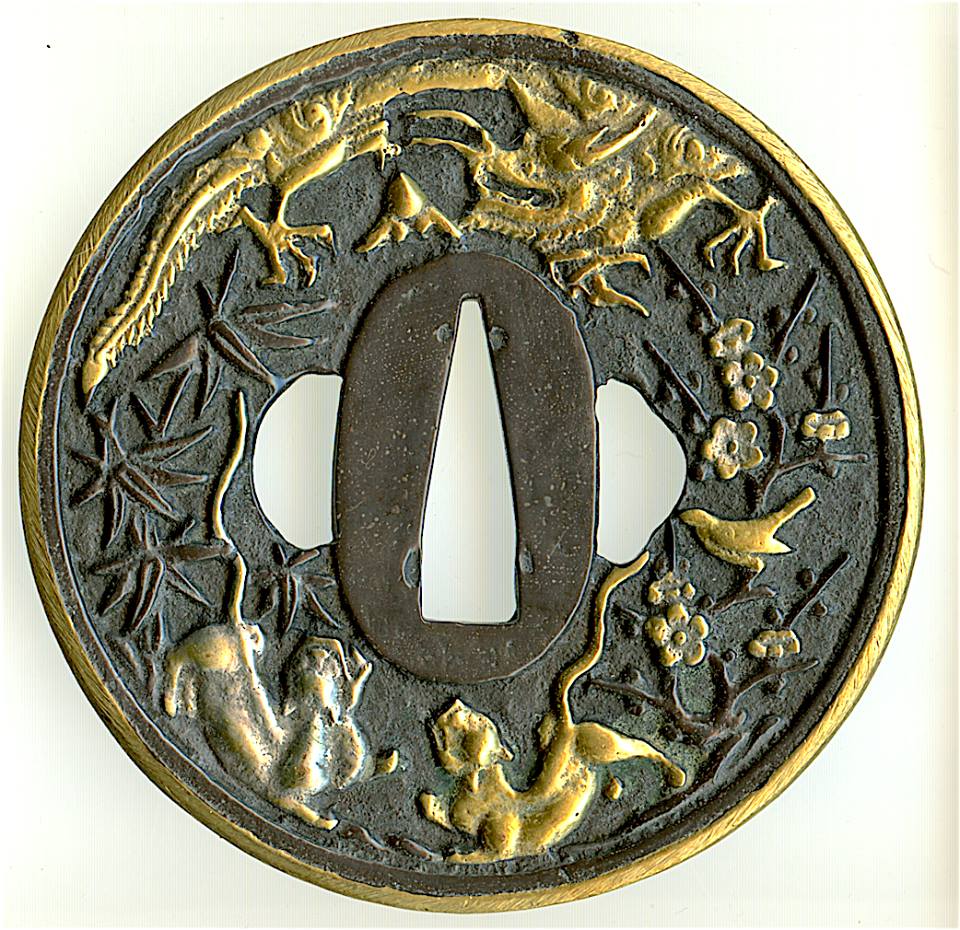 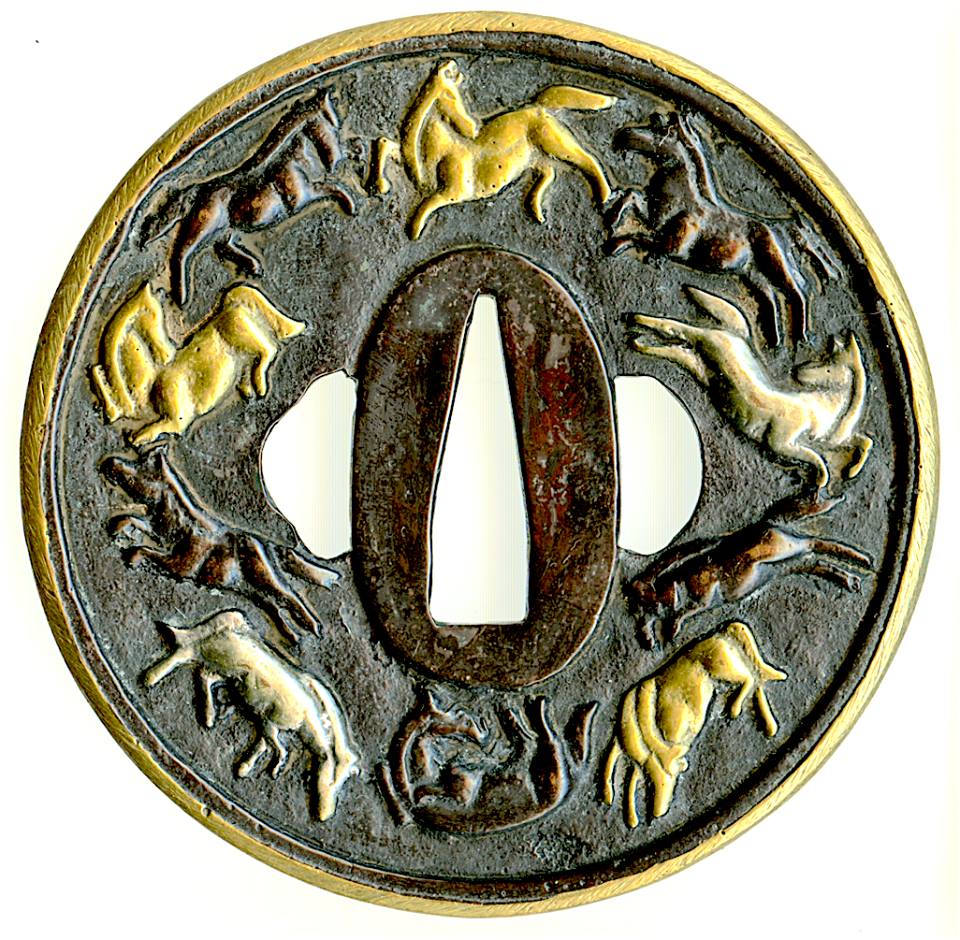 |
The smoking gun. Here we have a guard that is made in soft metal with a design in high relief adorned with gold and silver bullion leaf. The technique is not Japanese, nor is the felling of the metal or the carving. The form of the guard, and the sculptural language of the decorative elements identical to the iron guard in the previous post that showed such striking similarities of technique with a Sinhalese kastane garniture published on the Mandarin Mansion website. The seppa-dai looks identical to the general configuration of the Ceylonese guard, prior to its alteration. Using only the design as a comparison, we might say the soft-metal guard was also Ceylonese. But differences in technique rule it out. The craftsmanship is not Japanese, so where could it have been made. My guess would be Southeast Asia – Vietnam, which had strong ties with the VOC and a great fondness for Japanese weapons forms – which they produced domestically. One might hypothesize that a Tonkinese artisan copied a Ceylonese iron guard produced for the Dutch. Here is compelling circumstantial evidence proving that is what happened. On page 183 of volume VI of Nihonto Koza is an iron guard with the same peculiar method of brass inlay we see on the Sinhalese garniture. Its decorative scheme is identical to the soft-metal sword-guard that appears here. What are the chances that this is a coincidence? Probably less than zero. 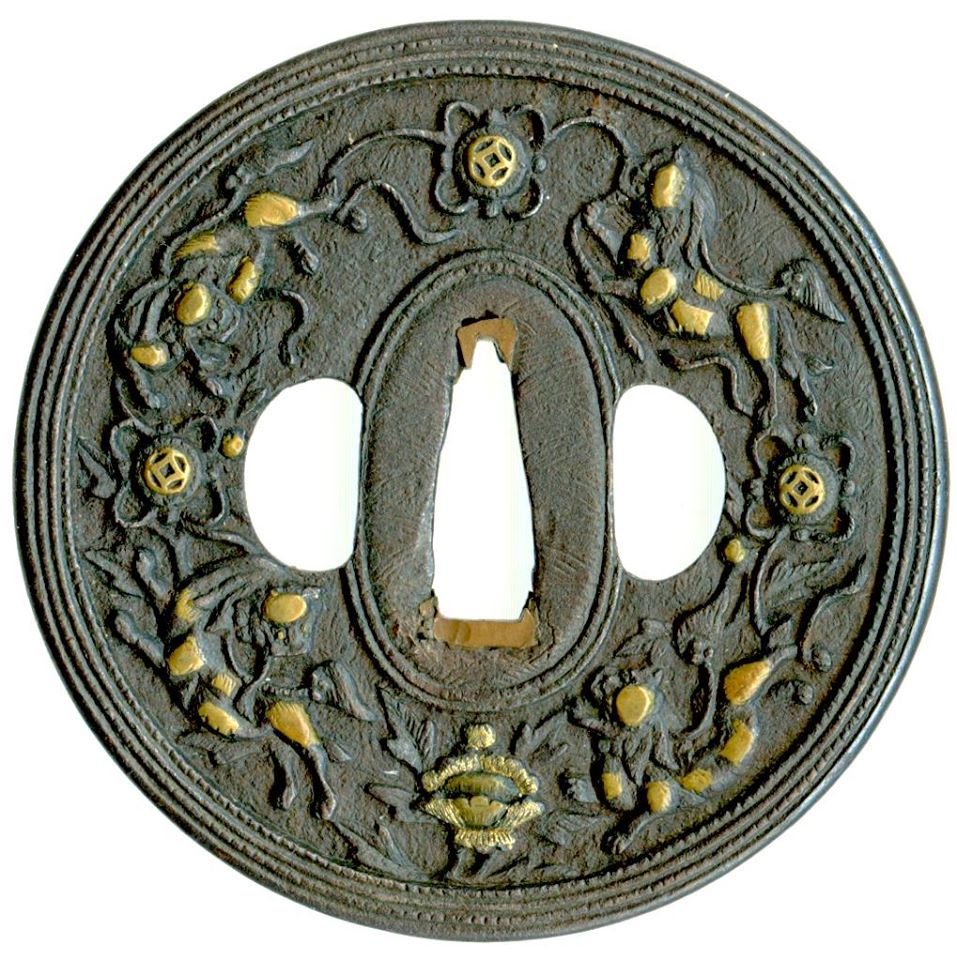 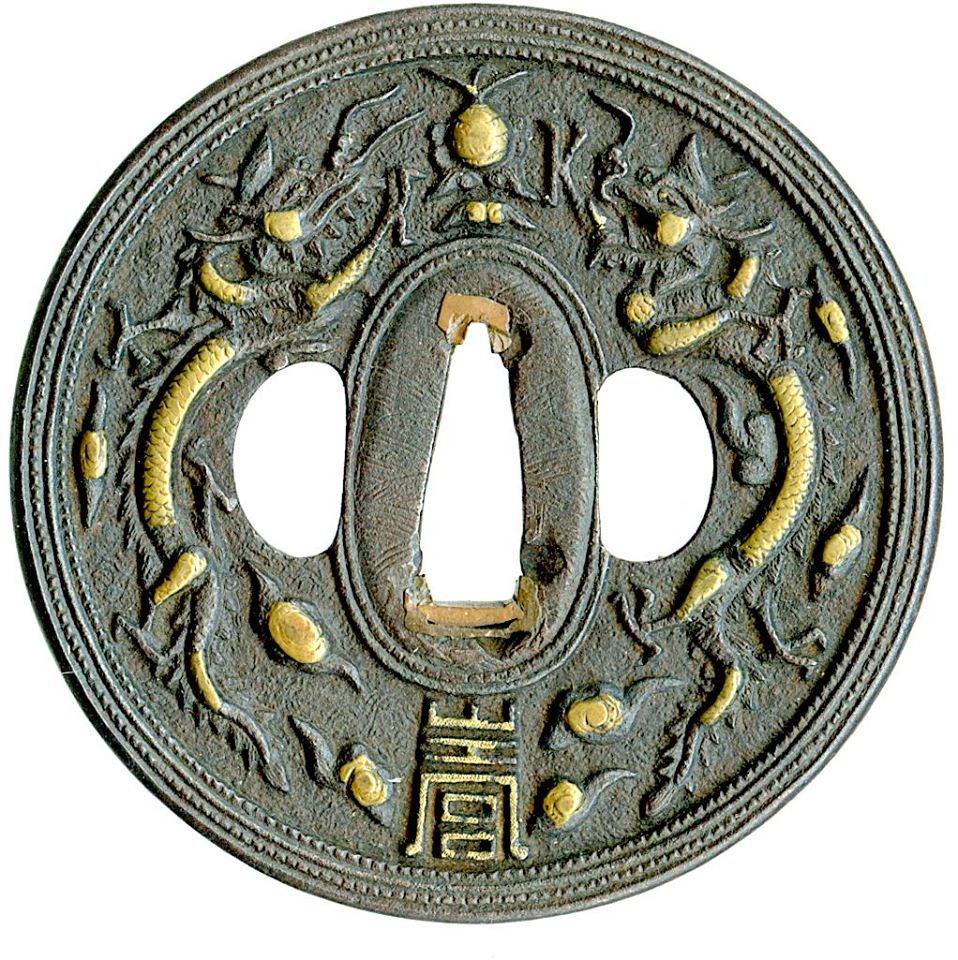 |
More fun with comparisons. Looking at this Chinese guard again, how do we date it? Answer: Clouds and dragons. Presuming that decorative motifs are contemporary, and long nostalgic reprises, we may create a timeline for certain stylistic points of identification. Ming clouds are formed with pointed "tails". Peter Dekker observed that during the Qing period (1644-1912) clouds gradually became rounder and lost their pointed ends. The other trait identified by Peter is that Ming-era dragon have flowing pointed forelocks and claws that tend to be spread open. Over time these traits diminish. By comparing the design on this guard with robes in portraits of Kangxi, (1654-1722) Qianlong (1711-1799) and Jiaqing (1760-1820), we can place the time of manufacture for this guard between late Kangxi and early Qianlong dates (1700-1750). Notice also that the dragon on the Ming pottery illustrated has three claws, not five. One should not assume that three claws is by default a Japanese dragon, but study the morphology of the entire beast. Many museums today have searchable websites if one cannot visit them in person. Also--anyone can communicate with a curator or collections manager to gain personal access to objects not on display. Be advised that certain etiquette applies. 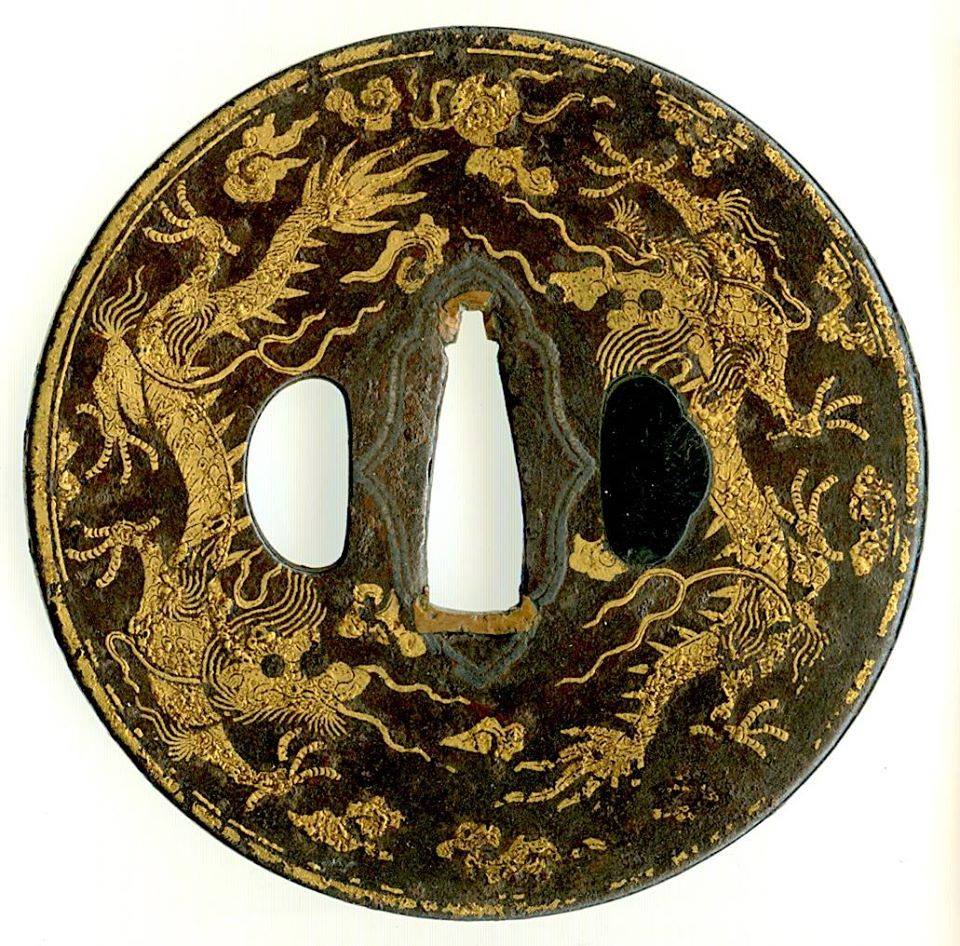 |
Asian Export sword guard. Iron with brass inlay and silver damascening. Dragon and phoenix motif. The Ho-o birds are carved on the recto in sunken relief reminiscent of carved lacquer while the surface of the guard is decorated in a foliate design that seems to replicate embroidered textiles. On the verso is the familiar motif of paired dragons chasing a flaming jewel, rendered in silver nunome (damascening). The delineation of the seppa-dai is most unusual, and on the reverse seemingly askew. The impractically formed kogai-hitsu is original to the design while the kozuka-hitsu seems to have been widened for Japanese use. One question is, if the intended use of this sword-guard was functional or artistic. The form of the kogai-hitsu resembles those found on what seem to be Sinhalese gift-guards made for the Dutch. The dragons express a kind of barbarous eccentricity. Can one cite the pointed cloud forms and say this is 17th century? No, because once a design trope enters the vocabulary, it remains forever. The paired “Kwanto-gata” dragon motif dates to antiquity. This guard combines multiple design traditions – Chinese, Islamic, and Japanese. It draws on other export goods like textiles and lacquerware. 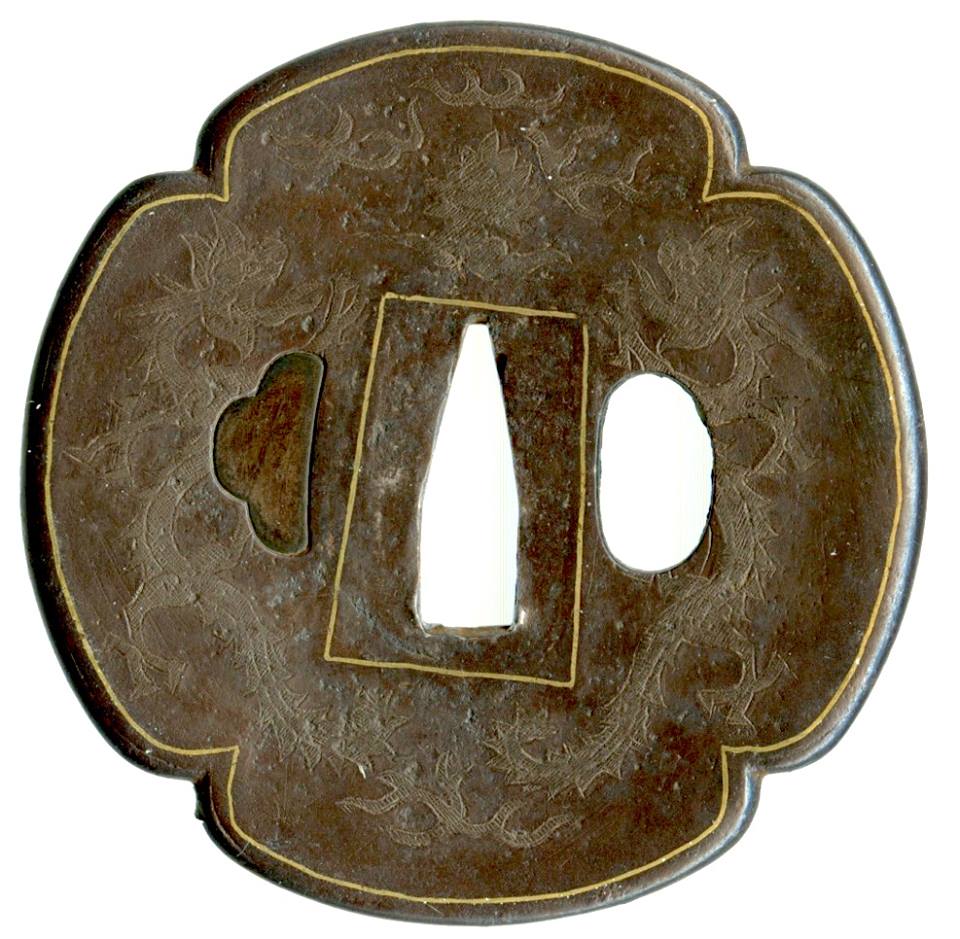 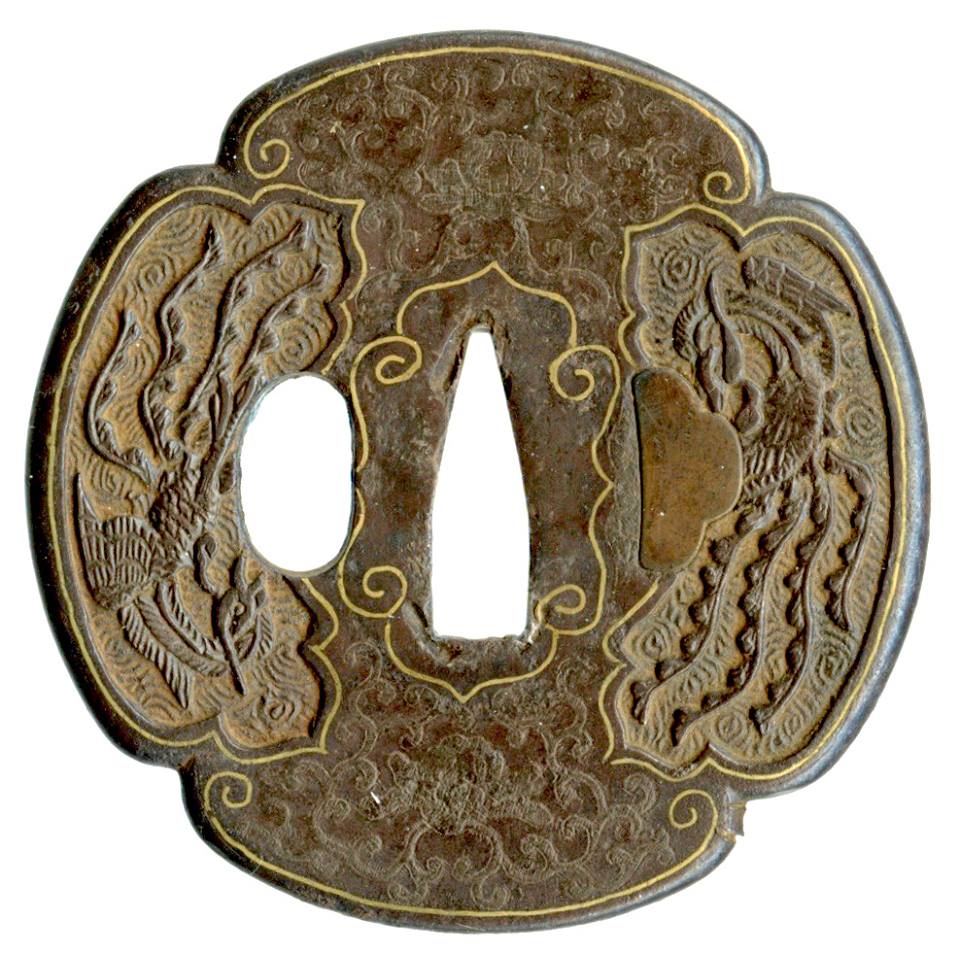 |
An intriguing Asian Export guard. The rounded squarish trapezoidal shape of this guard is said to indicate an earlier date of production--perhaps 1650-1700. The taper is slightly downward, which would seem to indicate that it was intended for use on a slung sword, such as was the custom in China and other parts of Monsoon Asia. The nakago-ana is instead cut to fit on an uchigatana mounting. The carving on the recto (omote) is executed in sunken relief (usunikubori) with raised rim, and highlighted in gold nunome (damascening). The number 8 is associated with good luck, here carved as an Arabic numeral. Neither the form, technique, morphology of the dragon nor character of the design is Japanese. The octagonal seppa-dai might be a clue. Some are found on Sri Lankan guards made for the VOC, which might indicate that this is a guard ordered by the Dutch. It lacks the peculiar brass-on-iron inlay technique associated with Sinhalese metalwork. The verso is flat, decorated with slim dragons in gold nunome. The nakago-ana indicates no evidence of Japanese use. The chiseling on the recto seems to be decorative, which would suggest that the intended use of this object was as a gift, or art object.   |
A truly barbaric sword-guard. One look at this piece is enough to dismiss it as Japanese. I imagine it being on a sword wielded by a Sarawak pirate or ferocious tribesmen deep in the mountains of Indochina. It is impossible to say without more examples for comparison, and hope that one of them has a signature or provenance. Iron with false damascening. 6.8 x 6.4 x .4 cm. There is a cruciform piece in the Jameel Collection at the Ashmolean Museum in Oxford, England with similar writing inside a cartouche at the bottom of the design that is attributed to Hirado. I have my doubts. 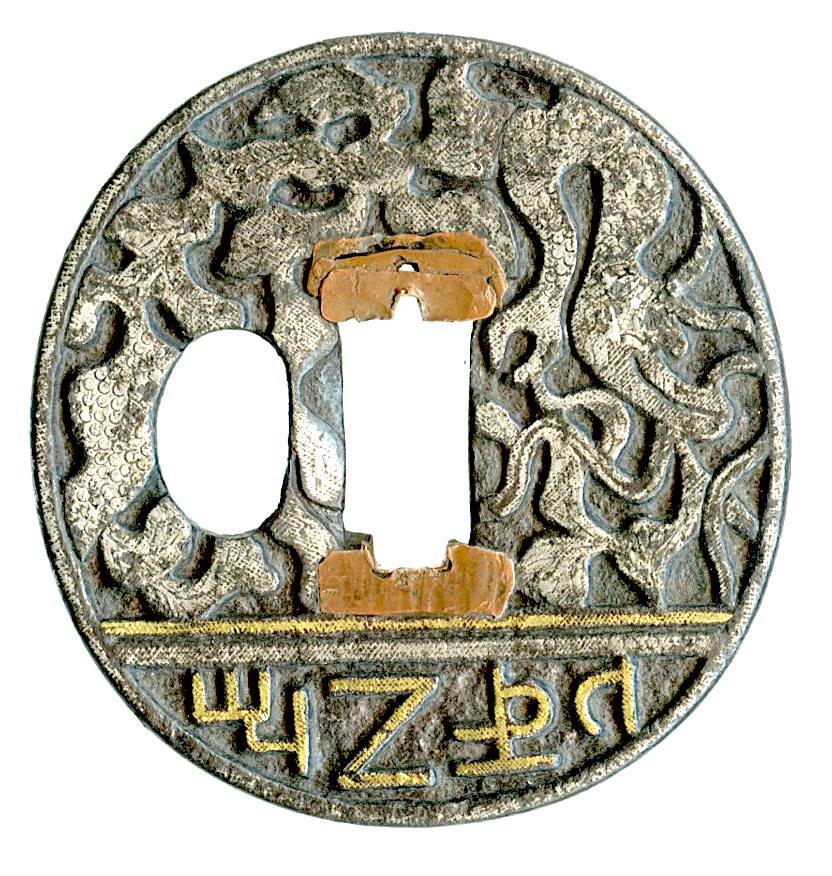 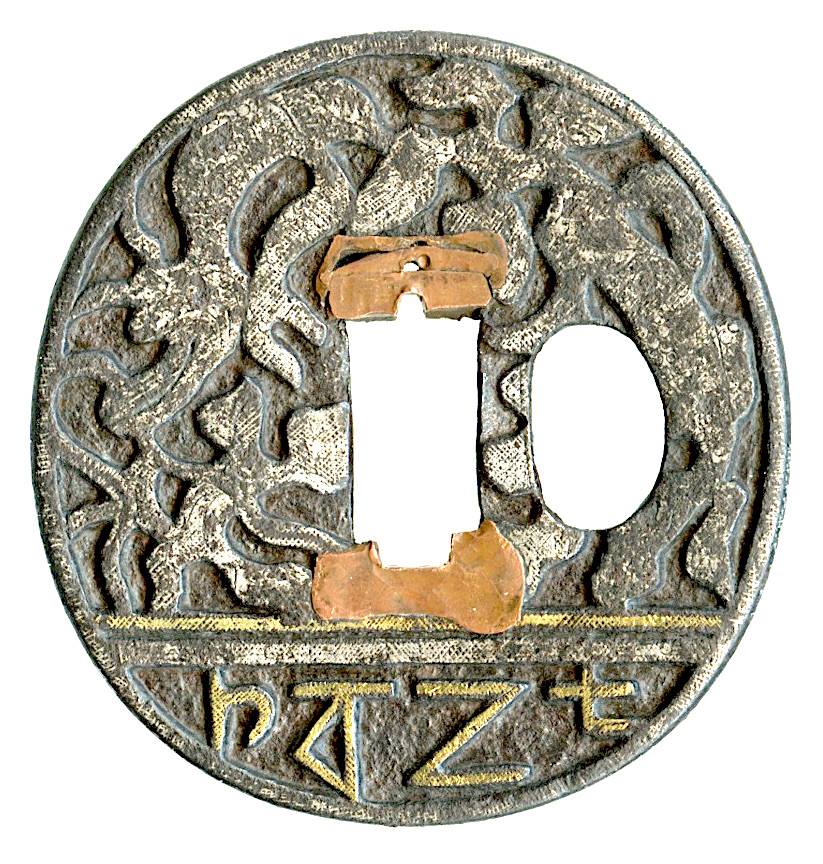 Barbaric Taste. Look at the seppa-dai. This cannot be Japanese workmanship. If presented to a shinsa, this truly eccentric sword-guard would receive the appellation of "Nanban". Once a certificate had been issued, the piece suddenly falls within the authority of nihonto aficionados, who had exercised minimal expertise in the act of attribution, which tells one no more than what one already knew. It's foreign, imported, "barbaric". The difference is that one now has a handsome certificate, which may elevate the guard's commercial value. One sees similar guards in many of the early European collections--usually of cruciform shape, with nonsense lettering in a cartouche at the bottom of the design. These are sometimes attributed to Hirado, which hints at a Korean connection. More likely is that this was made somewhere along the trade routes where Japanese swords had been exported during the Muromachi period--where discoid guards had been incorporated into local weapons design--places in contact with Chinese and European merchants, such as Burma and Malaysia. More study is required. The answer probably lies in other forms of decorative arts that share design elements, such as textiles and pottery. This should be classified "Asian Export" for now. |
Here is the problem. When an unsigned foreign-looking guard is submitted to a shinsa, regardless of whether or not it was made in Japan, it is judged as "Nanban". All the certificate says is "this is worth preserving" (please don't use it as a door-stop or wind-chime). Of course, if the maker is Japanese that would be another story. The same thing happens with iron guards that cannot easily be assigned to a known school. They are usually judged as "Shoami" (professional tsuba-maker). Not to be overly critical, but it would seem that the experts should be able to tell if a guard had been made in Japan, or somewhere else. This is why the new category of "Asian Export sword-guard" is necessary. Here is an example of a well-carved guard, made with the kind of tight form and fastidious workmanship characteristic of Japanese craftsmanship. The NBTHK awarded it a paper as "Nanban", while it would seem that the design of one hundred shrimp would be a clue. Because it most likely is no import, it is probably from Hizen; Nagasaki or Yagami--which lay a short distance to the northeast of old Nagasaki, and now is a suburb. The Noda Mitsuhiro school took in many students, and many of them became expert carvers working in Nagasaki, such as Hattori Yoshitsugu and Onitake Toshiyoshi. It would be impossible to say without finding a comparable guard with a signature. Sooner or later one will probably turn up. 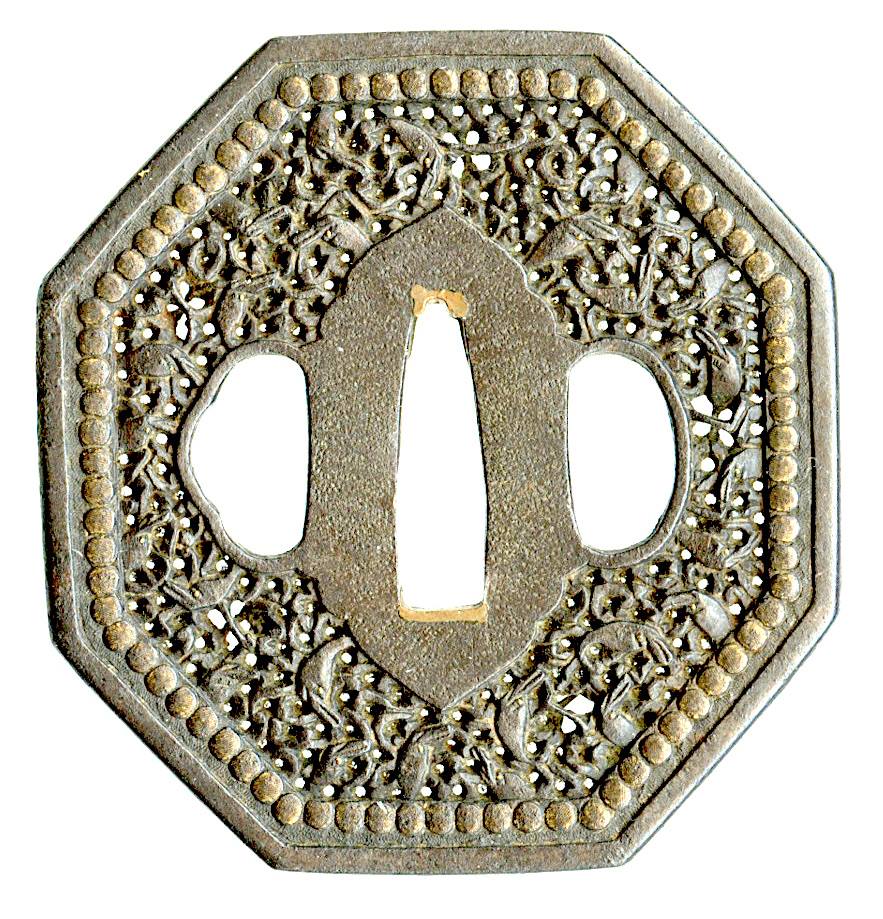 |
Asian Export sword-guard. A most curious design combining Chinese-Tibetan and Indochinese elements, such as this composite creature with the head of a lion and a serpentine body. The flowing mane is pointed, like the forelock of a Mekong Phaya-naga.The pointed shitogi-gata seppa-dai, pierced with a prefabricated nakago-ana to accommodate multiple tang systems suggest Monsoon Asia as place of origin--probably made to order for the VOC. The mode of forming the kozuka-ana, the fastidiousness of the carving, and the use of nunome (false damascening) is not unlike certain Hizen work (Onitake, Hattori, Yamada, etc.) Note how the bending tangle of Loukong interlacing seems to anticipate the kozuka-ana, which inset as a metal band--a technique used by the Yagami Mitsuhiro school. This guard appears to have never been mounted, which would agree with the notion that many such objects were made for use as gifts, and preserved as objets d'art. Multi-system nakagao-ana seem to be associated with guards made for the Dutch, who being in Nagasaki could surely have ordered guards from local metalworkers. The problem is that so far no records have been located at that level of specificity. Tsuba would have been deemed minor goods--things of no importance--and thus perfectly suited to many of the requisite gift-giving rituals. 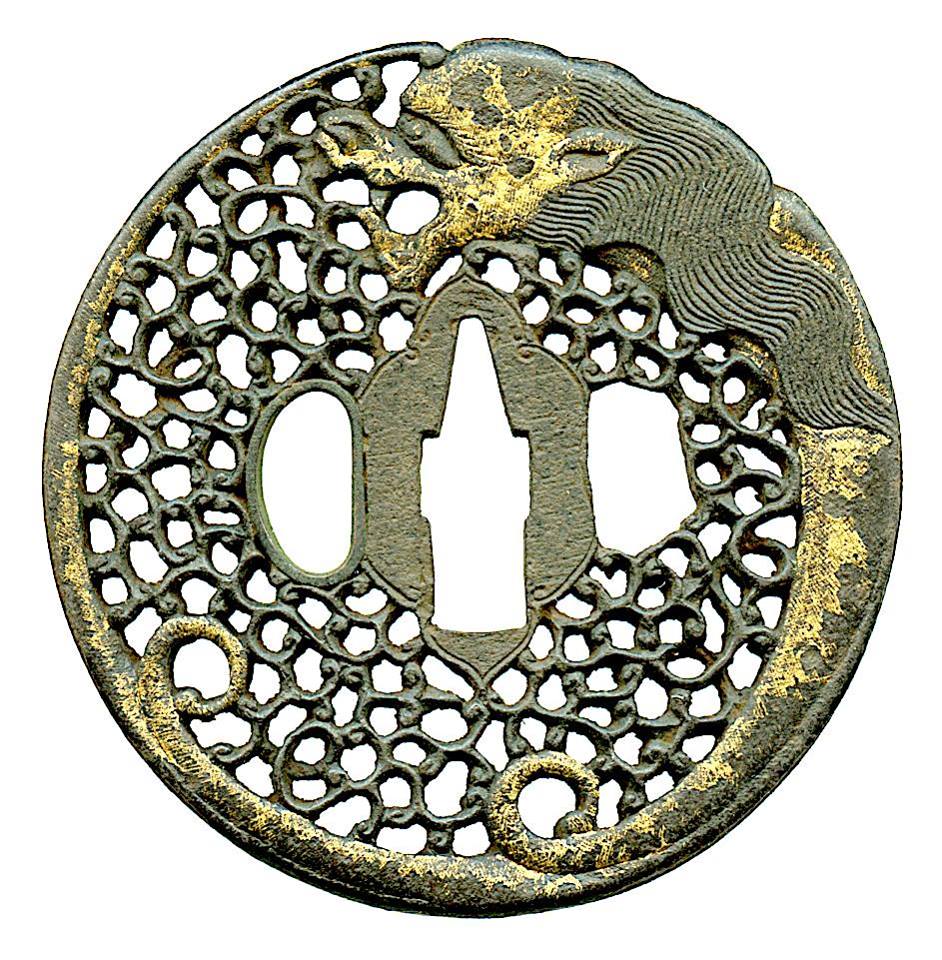 |
Orphan of the Storm: The form of this iron guard imitates some of the "auriculate" pieces coming out of Sri Lanka. This one has a crude, almost folk-art feeling--an attempt by some local carver to imitate pieces made for the Dutch by highly skilled craftsmen. The "loukong" interlacing--a Qing Chinese-Tibetan trope--is done by drilling and bending the metal instead of patiently carving and undercutting the tendrils. This is a very important point in judging quality in "Kanton" style guards. The directness of the carving and informality of finish makes me think it was produced outside of Japan, but I have no idea where. |
Humorous Asian Export sword-guard. The design is whimsical in the extreme; a goggle-eyed moustachioed Hollander with long blonde hair in place of a taotie mask, mixed in with other decorative motifs. The carving of the background resembles surfaces roughed up to receive champleve enamel. No vitreous residue is visible, so either the maker let it out of the atelier unfinished, or this is a specific style derived from enameling. Generally iron was a poor support. Adhesion was imperfect at best, leading to loss of enamel over time. There is one intact piece in the Jameel Center at Oxford, in the Ashmolean Museum. This design seems not to derive from or adhere to any regional craft-tradition, but expresses the kind of freewheeling liberty enjoyed by artists producing objects for the maritime export trade in Asian-style arts and crafts. 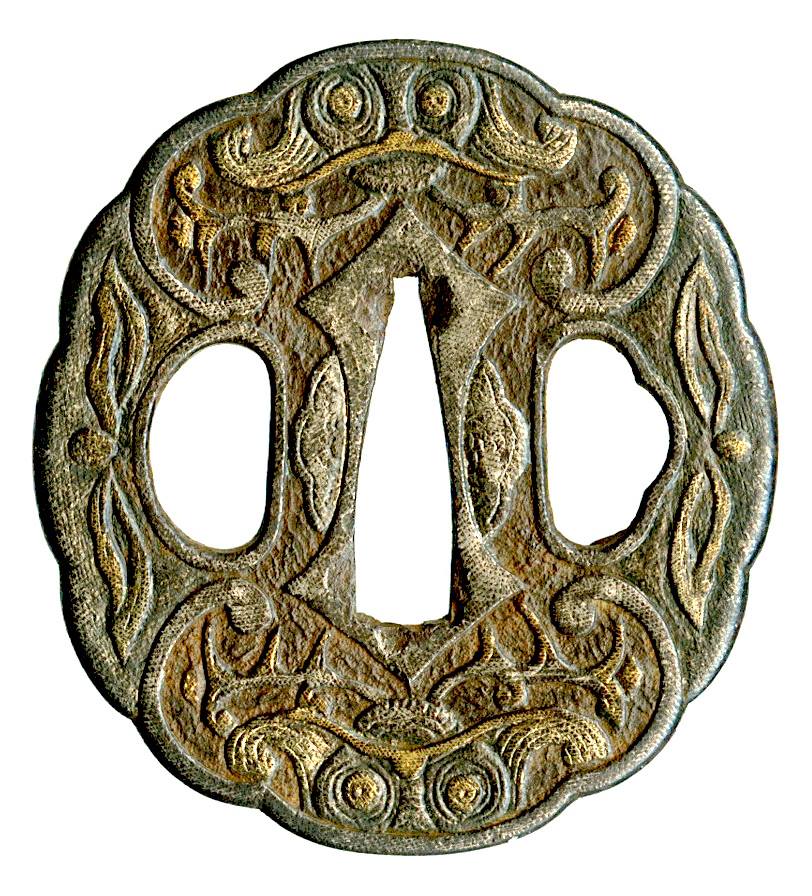 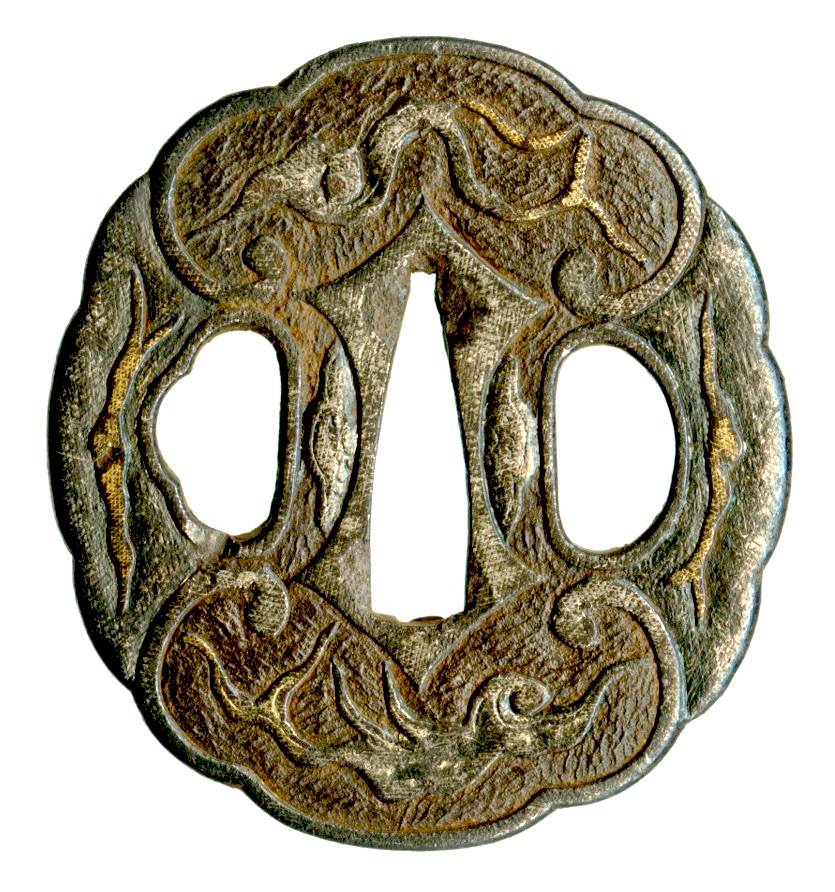 |
This design bears a resemblance to decorative motifs found on porcelain chargers produced for export. The nanako-like patterning of the background/field is slightly reminiscent of Iberian leatherwork, or it could represent the woven pattern of textiles. This piece in the collection of the Youseff Jameel Centre at the Ashmolean Museum in Oxford (published here under fair use) is listed as a "Hirado" tsuba, made in Japan. Bear in mind that the Sir. Arthur H. Church collection came to the Ashmolean as a bequest in 1915, around the time as the use of "Namban tsuba" as a general classification that included guards imported from China, Monsoon Asia and India, as well as copies of those guards, and other inspired by foreign styles produced by Japanese artists. Considering the configuration of the seppa-dai area, as a trapezoidal delineation with a circular cartouche, we may dismiss the notion that this work is Japanese. The nakago-ana has been cut through the plate, with utter disregard for the design, as have the hitsu-ana. Furthermore, the tama (jewel) that should sit at the top of the design is here found on the bottom, while the seppa-dai tapers upward. This can be taken as proof positive that this guard was intended to be worn in the Chinese style, with the cutting edge facing downward. Worn in the way the tama resumes it proper position at the top of the design. The question is where is it from, if not Japan? Could it be Korean? The Matsuura daimyo of Hirado maintained trade with Joseon despite exclusionary Sakoku edicts. More like the attribution was based on the use of brass as the base metal, a trait of the Hirado Kunishige school. Chinese influence is evident. No doubt there exist guards similar to this, which have been identified with a specific locality. 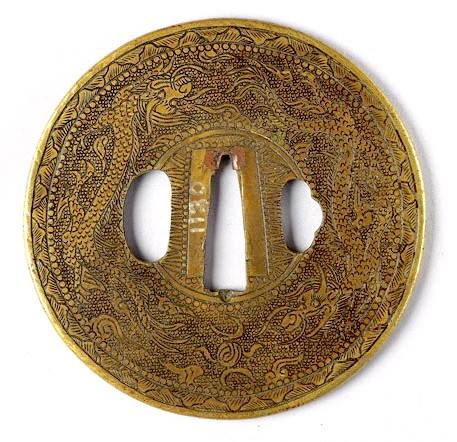 |
Nanban tsuba. Japanese copy of a Qing guard, with some modifications. Iron with gold nunome. 8.13 x 8.15 x .425 cm. 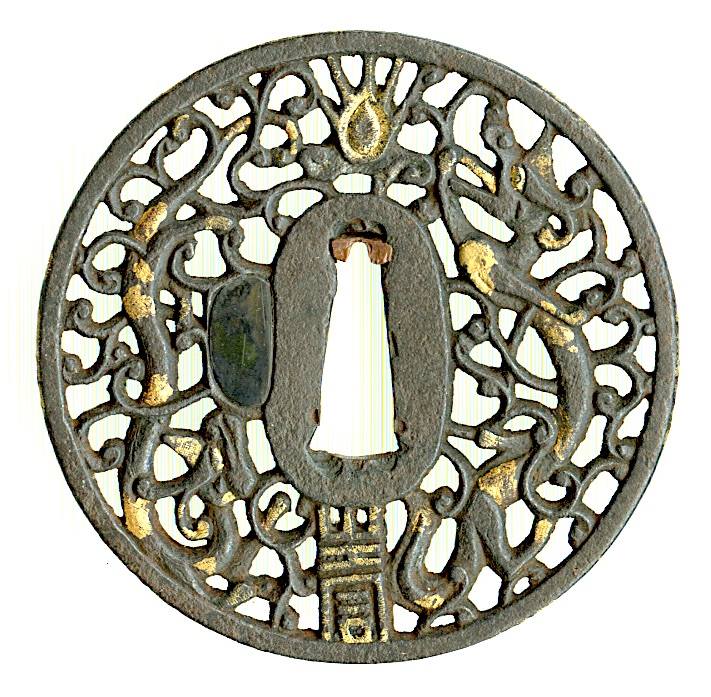 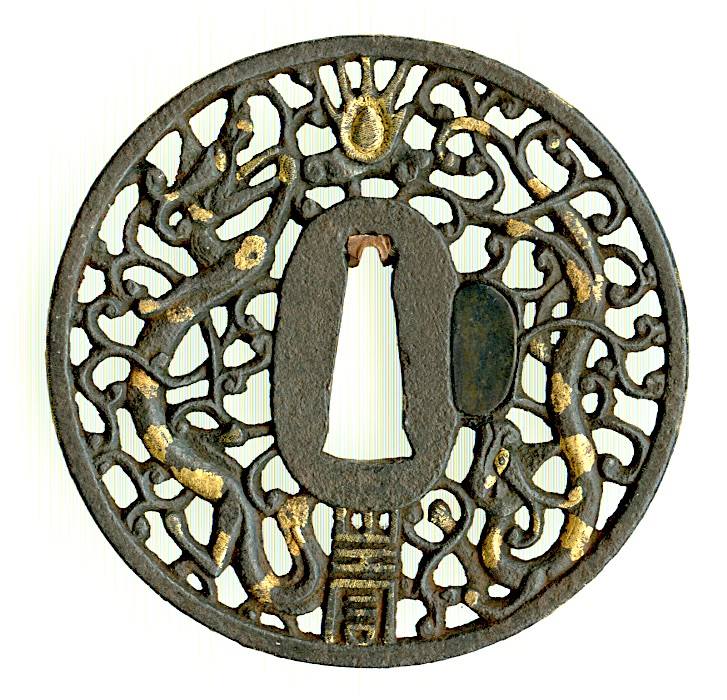 |
This small cruciform iron sword guard bears great similarity to two other guards, which have been subjects of previous posts. The carving technique is the same in all three, each of which is decorated with varying amounts of false damascening (nunome). Three of these guards bear nonsensical inscriptions in foreign-looking letters. The cruciform guard was given a Hozon (preservation-worthy) rating by the NBTHK and attributed as "Nanban". What does this mean? Was it made in Japan in a foreign style, or was it made outside of Japan and imported by the Portuguese, Dutch or Chinese? The Hozon paper does not elaborate. It simply states that the guard is "Nanban" (barbaric). One might question the value of such an attribution, if it cannot (or will not) classify the guard as a domestic product, or imported trade goods. All of these guards seem to have been produced outside of Japan, most likely in Monsoon Asia, perhaps Indochina. All three bear signs of Japanese use.The fourth piece in this lineup is from the Ashmolean Museum in Oxford, where it is identified as "Hizen". It bears a strong resemblance to the first specimen, which has seen more use. Discrepancies between the formation of the hitsu-ana suggest that these opening were cut though the design when the guards were mounted as part of a koshirae. The size differential might indicate an earlier date, possibly 1600-1650. C.R. Boxer decries a guard of identical design as shiiremono, but none of these attributions is very convincing, including my own. We must go beyond arms and armor, and beyond Japan, to seek the answer in comparable Asian export decorative art-objects.  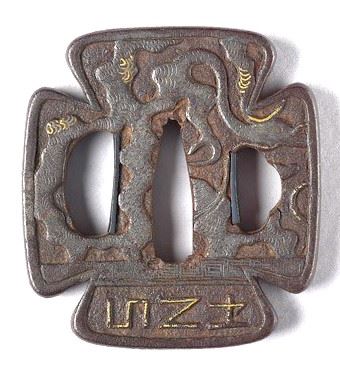 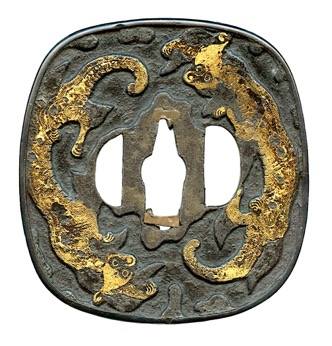  |
Chinese/Asian Export influence: Hirado Kunishige. The island of Hirado off the northwest coast of Hizen province had engaged in trade with Joseon for hundreds of years prior to the promulgation of Sakoku (locked country) edicts in 1636. Trade continued as we say, "grandfathered' under the law. The Portuguese established a trading factory in Hirado but were banished to Nagasaki and replaced by the Dutch and the British. The great English pilot and banner-man to Tokugawa Ieyasu, William Adams, is buried there. The Dutch were ordered to Nagasaki in 1641 where they maintained the only European trading-post in Japan until the opening of Japan in 1854. During the 18th century a group of metalworkers using the name "Kunishige" produced sword-fittings in copper, brass and shakudo decorated with Chinese designs, and at times European letters. Their tsuba are not copies of imported guards, but original designs produced after the Chinese style. An analogy for the relationship between China and Japan has long been compared to that of Athens and Rome. Twentieth century xenophobic nationalism constructed a mythology that portrayed Japan as isolated and self-reliant. History has shown that Kyushu at least, was very porous when it came to foreign trade, via Nagasaki, Kagoshima, Tsushima and Hirado. The Kunishige school seems to demonstrate the appeal of foreign influence. 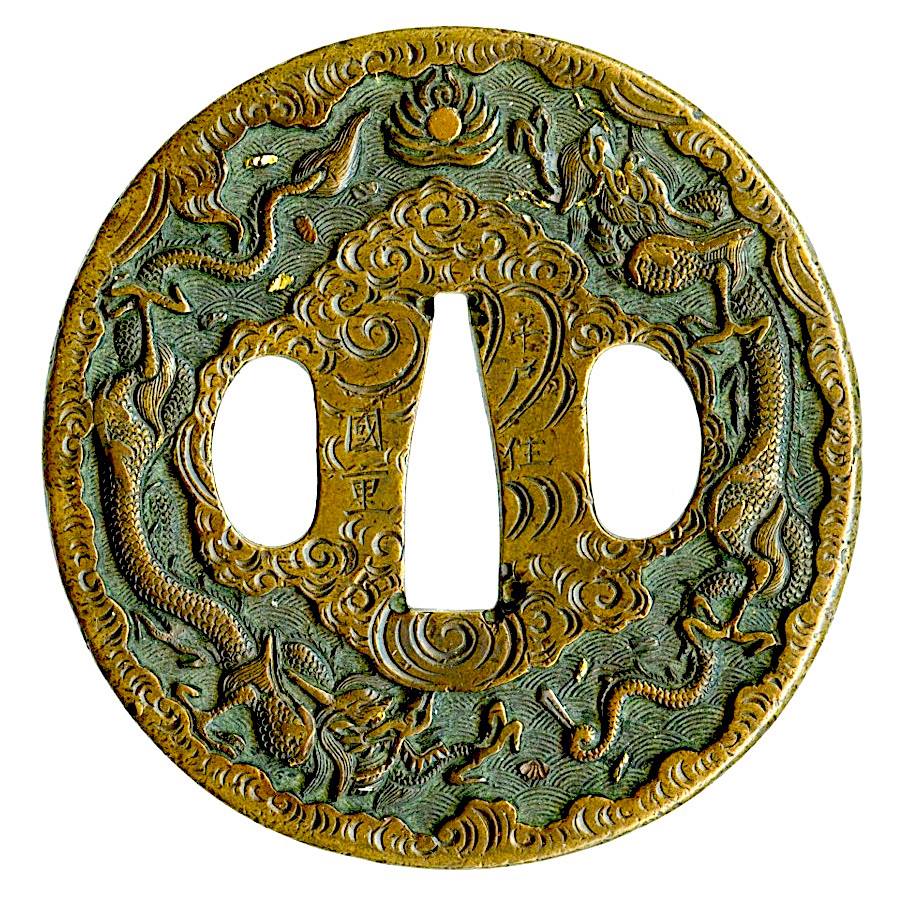 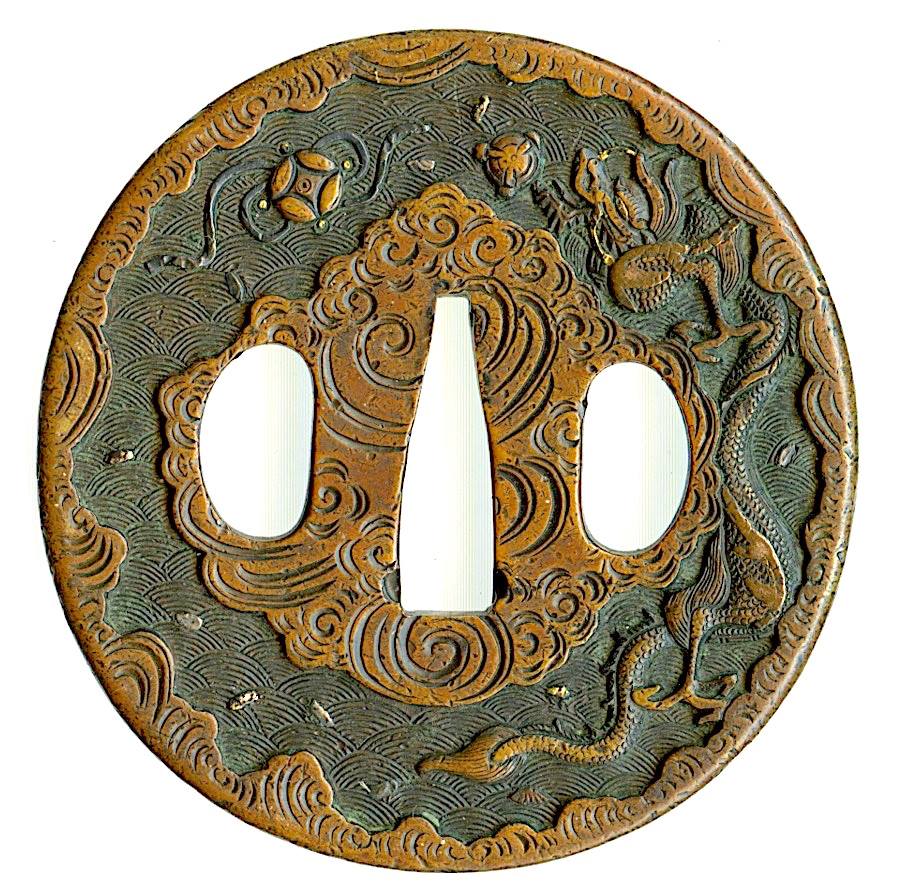 |
This piece is carved from a substantial iron plate, formed into a cup-shape (wan-gata), with a raised rim is set at almost a ninety-degree angle to the flat bottom of the concavity. The form is Chinese is design. Such guards are seen on Qing sabers (pei-dao). In all probability this guard was produced outside of Japan for local use and was acquired by Chinese or Dutch merchants, who brought it to Japan. Chinese influence was widespread across Southeast Asia, not so much to exertions of imperial power in a colonial sense, but due in part to the large number of merchants who were displaced by the Ming dynasty closing of its seaports in the late sixteenth century. The beaded rim, floral silver damascening, serpentine form of the dragons' bodies, together with the long pointed forelock express a feeling of Chinese-Monsoon Asia, seasoned with the dragon's cat-like paws adding an Islamic flavor to the design. The cloud-forms have pointed tails, a characteristic of Ming and early Qing design, as are the pointed forelocks. Tropes like this endured among Chinese communities outside of China, long after the fashion-forward Qing had moved on to more rounded cloud-forms and dragons with prescribed morphology that specified taloned feet. To be safe I would date this piece to ca. 1700, produced in a Chinese style somewhere far from the Qing court. 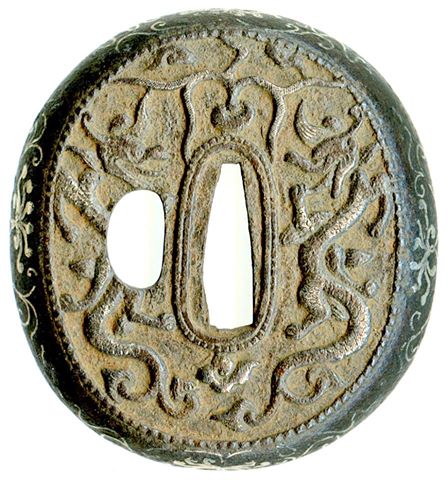 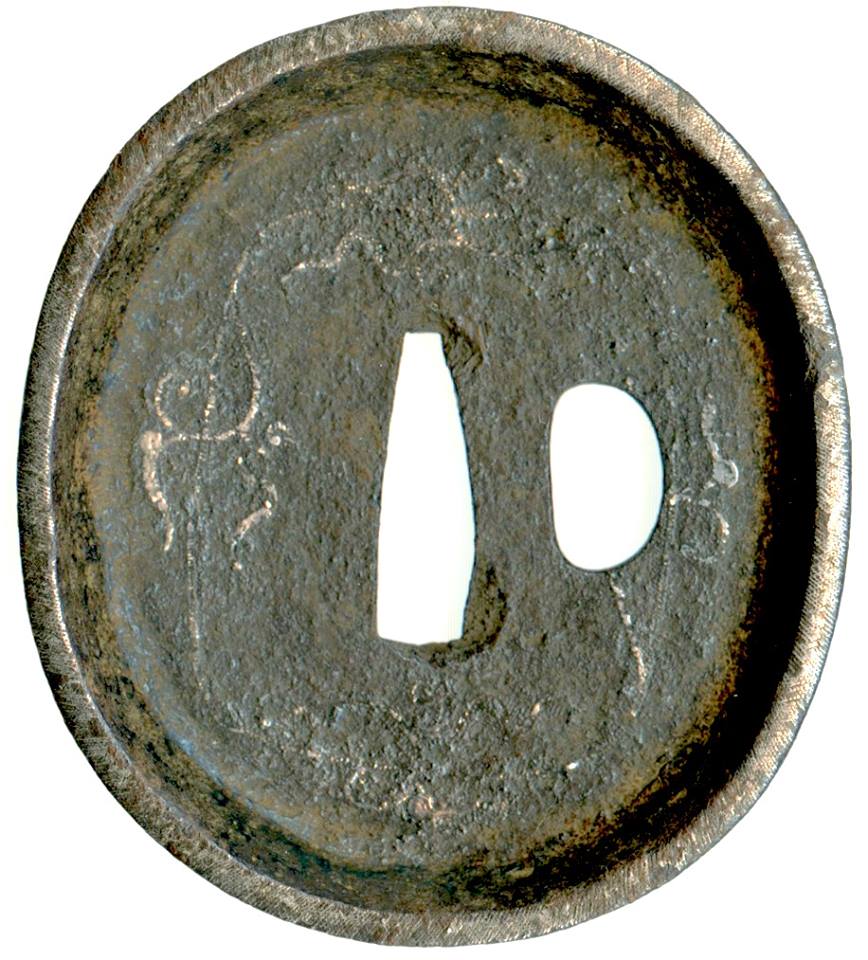 |
A couple of mystery pieces. The numbers six and eight are auspicious in Buddhist iconography. The drawer-handle motif is a common enough device in Asian decorative arts. The central flower might be read as a stylized lotus, but the nanako-like stippling is a curious feature on an iron guard. Tekkotsu exists in the rim of the smaller of the two. Both are relatively thin, carved wrought iron plates, not cast, The late John Lissenden referred to Nanban guards that copied Iberian leatherwork. Portuguese sea-chests were often made of tooled leather, as was some upholstery and wall-coverings. I suspect this may be the effect the makers of these pieces were trying to achieve. ("Nanako" by the way is also a special nubby weave of silk that resembles fish-roe). At an antique arms show recently I saw an identical piece lying on a table. The owner told me that it had been made by a member of the Yagyu family in 1928! 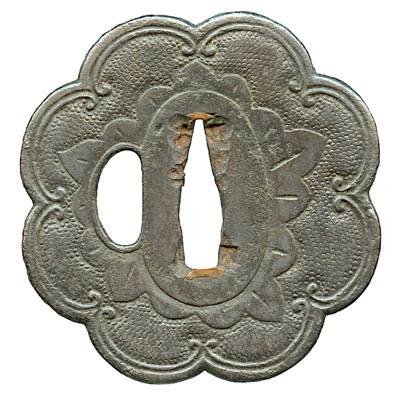 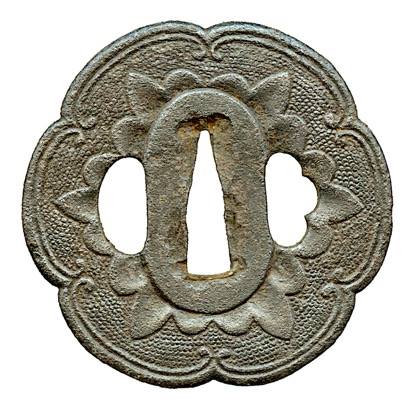 |
The manner of carving the floral design on the recto is reminiscent of the preparation for champleve enameling. The verso is decorated with a Roman alphabet. The seppa-dai is conventionally Japanese, with a foreign flavor. Some might ascribe this kind of design to early Hirado work, which resonates with some association with vitreous enameling. Completely different designs on opposite sides of the guard are seen with this kind of carving. There is also a piece in the Sir Arthur Church collection at the Jameel Centre at the Ashmolean Museum that retains its enamel. 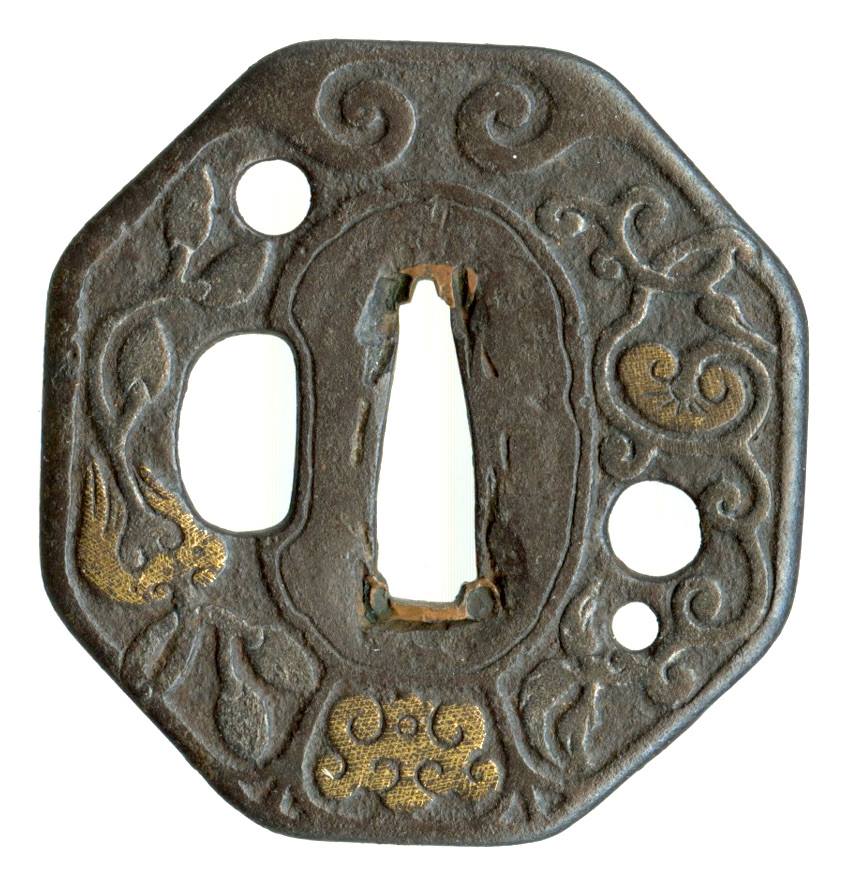 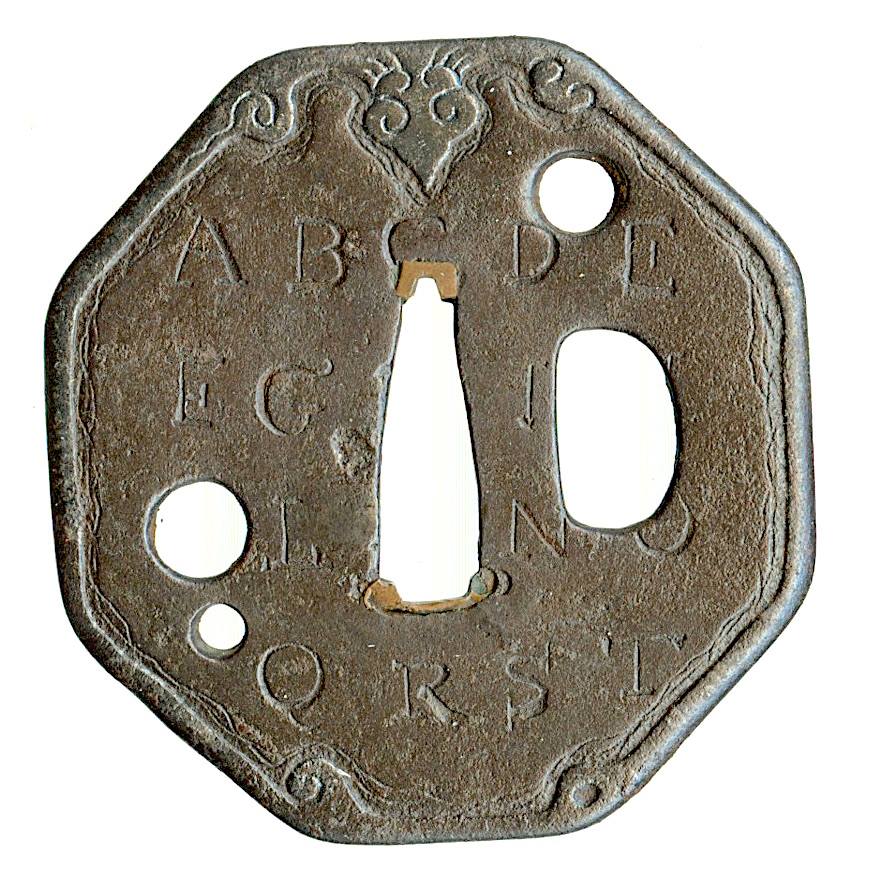 |
Iron Asian Export-style sword-guard. 7.99 x 7.98 x .56 cm. Dote-mimi, with Taoist symbols executed in taka-bori on ishime-ji. The verso is identical to the recto. almost circular form, raised rim and distribution of designs is reminiscent of Chinese mirrors. The presence of Taoist symbols alone should lead one to question the assumption that this piece might be Japanese. The symbols represented are clockwise from 11 o'clock: a pair of books (scrolls) representing learning, an Artemisia leaf representing good health, the leather fan of the Immortal swordsman/scholar Lu Dongbin, a jewel, or pearl; a Rhinoceros horn, and the lotus-flower of He Xiangu--protectress of good health. The elliptical formation of the seppa-dai might lead one to believe this is Japanese, but one must bear in mind that other countries--notably Vietnam--produced sword handles with oval cross-sections. As a result of isolationist policies enacted by the Ming Dynasty after 1450, a number of Chinese expatriate communities sprang up across Monsoon Asia. In all likelihood this guard was produced in China, or one of these foreign enclaves. My feeling is that it is early--pre-1640, but without verified comparables it would be impossible to determine. The piece was awarded a Tokubetsu Kicho paper by the NBTHK in 1974, with an attribution as "Nanban" (what else is new?). One wonders why shinsa teams not distinguish between imported guards and copies of those guards produced in Japan, and if they can, why they do not. |
Possibly Sri Lankan sword guard, of a type produced for the Dutch for use as gifts. Note the Japanese modification to the original kozuka-hitsu to make it functional. As made, its function was purely decorative. This is a sign that it is not of Japanese manufacture, by a carver who might have been familiar with Japanese swords. Trade routes linked Sri Lanka with Japan via the Portuguese, and later by the Dutch, whom we know ordered weapons from Sinhalese armorers for use as gifts to Asian potentates and business associates. This is an especially fine example of Asian Export metalwork. The brass inlay at the top of the high relief is incised with delicate line-engraving. This method of capping high relief in iron with brass inlay seems to be a hallmark of Sinhalese metalwork--very different from the so-called Onin tsuba or Heianjo-zogan works associated the Japan. Offered for comparison is a 17th century Sinhalese "Kastane", with quillion and knucklebow produced in this manner. The Dutch are known also to have engaged Sri Lankan metalworkers to produce garnitures for Solignen blades, which were then exported to Asian and European markets. Colonel Alexander Popham (1605-1669) is shown wearing one of these swords in a portrait in the Royal Armory in Leeds, England. A few other comparables are included. The seal-script at the bottom is the name of China’s Great Central Mountain, Song-Shan, a symbol of the unity of the people under the protection of the emperor. This device is seen on many guards of the Qing period, especially Qianlong. Such symbols might also have been found on porcelain and other trade goods. In this case, it most likely is merely a decorative motif to give the piece a Chinese feeling. The delineation of the leopards' fur and birds' plumage is an elegant touch. This guard seems to epitomize the spirit of Asian export art, combining decorative elements from multiple sources, expressing artistic refinement and exotic allure. One of the problems with Japanese taxonomy is that it expects the rest of the world to behave according to its rules. Never mind that the whole notion of taxonomy was invented by a Swedish botanist named Linnaeus. In Japanese sword fittings classifications, all works can be assigned to neatly defined categories. Those that cannot are simply classified as "Shoami" (professional tsuba-maker), or "Nanban" (foreign). In the case of foreign sword-guards, most were made in places where carvers never signed their work, or for that matter gave a toss if Japanese carvers did. The thesis here is that this piece was made in Sri Lanka, based on materials and technique. What of subject and style? The top of the design represents foxes and grapes, one of Aesop's fables. (Greek mythology) Let's look at the horses and ask, do they look Japanese? Of course not. If we look at Persian and Mughal miniatures, we see horses closer to the morphology of those found on this guard, with long curving necks and narrow heads. Japanese horses are stockier, less elongated. The same is true of Chinese horses. Qing animal painting was heavily influenced by European verisimilitude, which is seen in works by painters of the Nagasaki school, who had studied with Nan'ping. If the decoration on this Japanese-form sword-guard is sourced from Islamic art (with its strict rules of representation), and the design includes a Chinese imperial device, the whole being executed using a Sinhalese technique, what we have is a mishmosh of styles and methods. In other words, a hybrid typical of asian Export art. The Dutch are known to have ordered swords and other weapons from Sinhalese armorers, at the same time they maintained a trading factory in Dejima, Nagasaki. The evidence is here. The pieces fit.   |
When something fails to fit neatly into a known classification but looks Japanese, it might be classified "Shoami" (professional tsuba-maker), or "Nanban" (foreign-style). In conventional "Kantei" the formation of the washer-seat (seppa-dai) would be but one point of judgment, but one that might be argued to be of paramount importance. It tells us the shape of the sword-handle, and the shape of the blade-tang, which can tell us whether or not the guard was made for a Japanese sword. These three examples were all produced in Japan, but influenced by foreign styles. The single feature they all share is a "signature" treatment of the washer-seat: raised gilded border and silvered surface, engraved with clouds. This strongly suggests that they could have been made in the same atelier. Judging by the size and form of the seppa-dai, and the Sawasa-like foliate scrollwork similar to the Tekkai-Sennin piece, it might be an offshoot of the Yagami school, working in Nagasaki. In the absence of signatures, with more specimens to study, comparisons like this might lead us to firm attributions.   |
Chinese-style "seppa-dai" (blade/handle seat). One of the points of judgment in identifying an imported guard from a Japanese tsuba is the shape and orientation of the "seppa-dai" (Can someone provide a Chinese translation?). In a Chinese guard the trapezoidal surface is made to taper slightly toward the edge of the blade. Because the sword would be worn edge-down, the top of the design would be at the broad end of the taper. In Japanese copies of Chinese and Monsoon Asian guards, the taper might be reversed, or eliminated altogether.   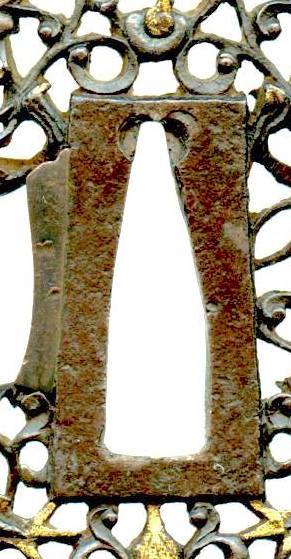 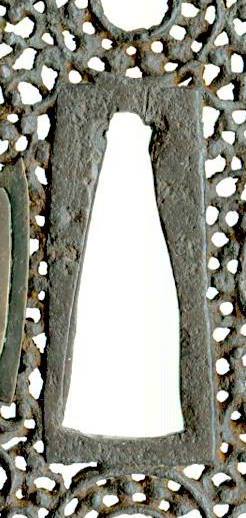 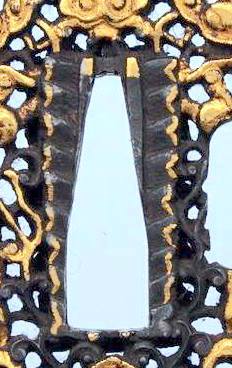 The key difference between Chinese and Japanese seppa-dai is the shape, which reflects the difference in shape between the elliptical cross-section of the Japanese tsuka and the rectangular/trapezoidal cross-section of Chinese sword-handles. That said, I believe that many so-called "Nanban" guards were not created for practical use, but as objects d'art to be employed in gift-exchange rituals. They might have been mounted later. In my humble opinion, a good direction in which to collect would be non-Japanese discoid guards bearing clear signs of Japanese use. There are some collectors who will just assume that a discoid guard is Japanese. This would be an error. "Barbarous" guards were made in China and all over Monsoon Asia. One must judge each on the grounds of artistry, and avoid the Yokohama paperweights that are also out there. Learn to recognize the difference. Always look at the seppa-dai. |
Return to Asian Sword Guards | TSUBA